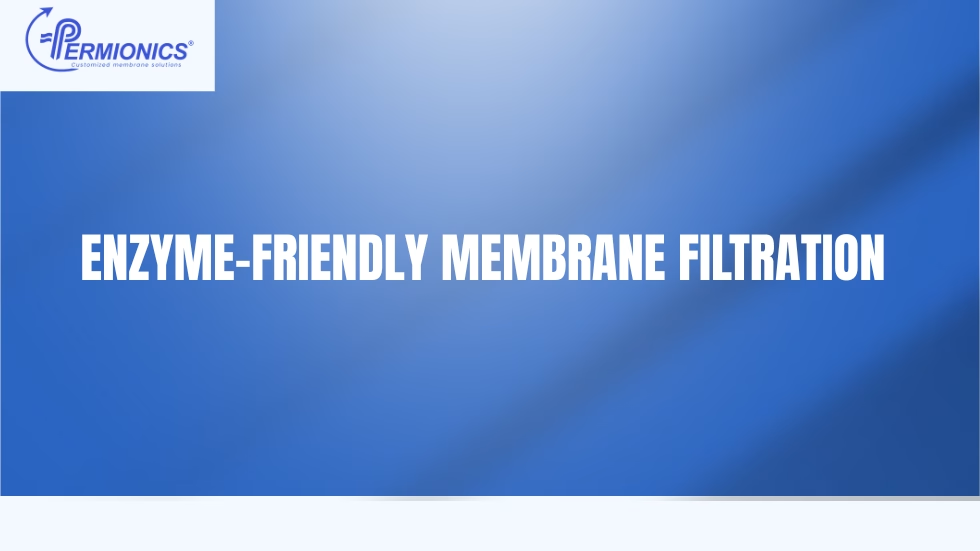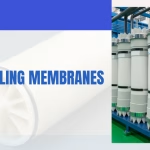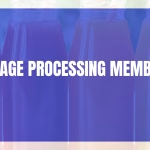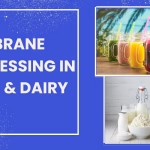Have you ever wondered why some foods taste fresher, hold their texture longer, or feel closer to their natural state than others? The answer often lies in how gently they are processed. Heat and heavy treatments may make foods safe, but they can also strip away enzymes that are vital for nutrition and flavour. This is where enzyme membrane filtration is stepping in, offering a way to protect what really matters while still meeting modern quality standards.
What is Enzyme Membrane Filtration?
At its core, enzyme membrane filtration refers to the use of membranes (filters with specific pore sizes or molecular weight cut-offs) to separate, clarify, concentrate, or purify food products in a way that does not inactivate desirable enzymes. The priority is preserving enzyme activity, avoiding high heat or harsh conditions.
This contrasts with traditional thermal treatments (pasteurization, sterilization), which can degrade enzymes and change nutritional and sensory properties.
Why Food Quality Demands Enzyme Membrane Filtration
- Preservation of Nutritional Value: Enzymes often help in digestion or in maintaining certain vitamins. When you retain enzyme activity, many benefits remain.
- Taste & Aroma: Enzymes contribute to flavour development. Harsh heat or extreme conditions can reduce aroma volatiles.
- Texture & Appearance: Membrane filtration can remove unwanted particles or turbidity without affecting proteins or enzymes that give texture.
- Microbial Safety: While preserving enzymes, filtration can remove microbes, spores, or undesirable particles.
The Role of Filtration Process Use in Enzyme Applications
“Filtration process use in enzyme” means how filtration steps are integrated when working specifically with enzymes—whether in purification, stabilization, concentration, or in downstream processing.
Some applications:
- Enzyme production: After fermentation, membranes help separate biomass and concentrate enzyme solutions.
- Juice clarification: Enzyme pre-treatment (pectinases etc.) helps reduce fouling, then membranes clarify juice while retaining aroma compounds.
- Protein hydrolysates: Enzymatic hydrolysis with membrane filtration gives protein-rich fractions with target functionality. Example: potato juice experiments used a 1 kDa ultrafiltration membrane after enzyme treatments to generate protein hydrolysate.
- Dairy ingredient standardisation: Using ultrafiltration (UF) or microfiltration (MF) with lower temperatures keeps enzyme/system functionality high. Filtration process use in enzyme contexts ensures less damage and more active components.
How Enzyme Filtration Solutions Work
“Enzyme filtration solutions” refers to the specific technologies and strategies used to implement enzyme-friendly membrane filtration. Key aspects include:
- Membrane type & pore size / MWCO (Molecular Weight Cut Off): To allow passage of desired molecules while blocking unwanted ones. For enzyme preservation, MWCO must not block or denature enzyme molecules.
- Temperature control: Keeping temperatures low (< 20 °C or even < 15 °C in many dairy applications) to prevent thermal inactivation. Studies show ultrafiltration of skim milk at <15 °C improves functional proteins vs. typical 50 °C processing.
- Flow type: Cross-flow (tangential flow) vs dead-end filtration. Cross-flow helps reduce fouling, remove debris, and better preserve enzymes.
- Enzyme or pretreatment additives: Use of enzymes (e.g. proteases, pectinases) before or during filtration to reduce fouling, increase permeability, improve flux. Example: ultrafiltration of rapeseed protein concentrate with pectinase decreased fouling.
- Cleaning and maintenance: Gentle cleaning, avoiding harsh chemicals or high temperatures that might damage membranes or residual enzyme activity.
These are the types of enzyme filtration solutions that food manufacturers are investing in now.
Data & Case Studies: Membrane Technology in Food Processing
Looking at some real data helps us see how membrane technology in food processing works in practice.
- Dairy Cold Microfiltration & Ultrafiltration
- In dairy, moving MF & UF operations to < 20 °C reduces fouling. Cold MF produces higher yields of proteins like β-casein, while reducing denaturation.
- One study reports that UF of skim milk conducted at low temperature (< 15 °C) gives better protein functionality and less plasmin activity (enzyme that degrades other proteins).
- In dairy, moving MF & UF operations to < 20 °C reduces fouling. Cold MF produces higher yields of proteins like β-casein, while reducing denaturation.
- Rapeseed Protein Concentrate with Pectinase Pretreatment
- Vegetable Processing & Water Reuse
- Global Market Growth
- The membrane filtration market was valued ~USD 19.45 billion in 2024. It is expected to reach ~USD 44.01 billion by 2033, growing at a CAGR of ~9.5%. Much of this growth is driven by food & beverage sector demand around quality & safety.
- Another projection: the global market for membrane filtration in food and beverage is expected to grow from ~US$7.2 billion in 2024 to ~US$9.7 billion by 2030
These case studies show that enzyme membrane filtration, with thoughtful enzyme filtration solutions, is more than theoretical—it delivers measurable gains in yield, quality, safety, sustainability.
Benefits of Enzyme Membrane Filtration
Putting together the points above, here are the main benefits when implemented well:
| Benefit | What It Means in Practice |
| Retention of active enzymes and proteins | Less thermal inactivation; better nutritional content and functionality. |
| Cleaner products | Turbidity, particles, unwanted solids removed without damaging enzymes. |
| Improved flavour, aroma, texture | Since the enzyme systems are preserved, sensory qualities are enhanced. |
| Higher safety & lower microbial load | Filtration plus temperature control reduces microbial risk. |
| Lower energy / water use | Membrane filtration often requires less energy vs boiling or thermal techniques; wastewater can be recycled (like in carrot plant example). |
| Reduced waste and fouling when using pretreatments | Enzyme pretreatments reduce fouling, increase flux, lower downtime. |
Challenges & Considerations
No technology is perfect. Here are challenges to using enzyme membrane filtration:
- Fouling: Even with cold filtration, membranes foul. Pretreatments and regular cleaning are necessary.
- Flux reduction: Lower temperatures can lead to higher viscosity which reduces permeate flux, needing adjustments in pressure or membrane design.
- Cost: Membranes, equipment, and upkeep cost more than simple filters. Enzyme pretreatments or specialized solutions raise costs.
- Membrane lifespan: Harsh cleaning chemicals or misuse can degrade membranes, especially those optimized for enzyme preservation.
- Regulatory and safety compliance: Ensuring that the filtration process removes harmful microbes without removing or denaturing beneficial enzymes.
Best Practices for Implementing Enzyme Membrane Filtration
For food companies or labs considering enzyme membrane filtration, here are proven best practices:
- Select appropriate membrane type & MWCO based on enzyme size & target molecules.
- Maintain low temperature operation (often < 15-20 °C) to preserve enzyme activity.
- Use pretreatment steps (e.g., enzyme pretreatment, pectinase, protease) to reduce contaminants and fouling.
- Adopt cross-flow filtration where possible, to maintain flow, reduce deposit build up.
- Monitor membrane performance metrics (flux, rejection, fouling rate, enzyme activity) regularly.
- Gentle cleaning protocols: use mild chemicals, enzyme-based cleaners, avoid repeated high heat or harsh pH swings.
- Pilot testing before scale-up: small trials can help set effective settings (temperature, pressure, flow).
Why Permionics Membranes Stand Out in Enzyme Membrane Filtration
When it comes to enzyme membrane filtration, the choice of membrane supplier is critical. Permionics membranes are considered highly suitable for food industry applications because they are engineered for precision separation, durability, and enzyme preservation.
- Tailored Pore Sizes & Cut-Offs: Permionics designs ultrafiltration (UF), nanofiltration (NF), and reverse osmosis (RO) membranes with a wide range of molecular weight cut-offs. This flexibility allows manufacturers to select membranes that retain valuable enzymes while letting smaller unwanted molecules pass through.
- Low Fouling Properties: Food processing often struggles with fouling and flux decline. Permionics membranes are known for their advanced polymer chemistry and surface modifications that resist fouling. This makes enzyme membrane filtration more reliable and reduces downtime.
- Enzyme Stability: Since enzyme activity can be reduced by heat or chemical stress, Permionics membranes are built to operate effectively under low-temperature conditions and moderate pressures. This preserves enzyme integrity, ensuring food retains its natural quality.
- Sustainability Advantage: Many Permionics membranes are designed to reduce water consumption and energy requirements, making them more sustainable compared to older filtration setups.
By combining performance, durability, and enzyme-friendly design, Permionics membranes make enzyme filtration solutions practical and scalable for the food sector.
Products Where Enzyme Preservation is Crucial
Enzymes play a vital role in many food and beverage products. Preserving enzyme activity during membrane filtration ensures these products retain their quality, taste, and nutritional value. Below are some key examples:
1. Dairy (Milk & Cheese)
Enzymes like lactase and rennet are central in dairy processing. Lactase helps in lactose-free milk production, while rennet drives cheese coagulation. Preserving enzymes during enzyme membrane filtration keeps these processes efficient and improves product yields. The global lactose-free dairy market alone is projected to reach USD 21 billion by 2030, highlighting rising demand.
2. Juices & Beverages
Enzymes such as pectinase and cellulase are used in juice clarification and extraction. Using enzyme-friendly membranes ensures that juices remain clear, aromatic, and nutrient-rich. With the fruit juice industry projected to exceed USD 200 billion by 2032, enzyme preservation is critical for consistent quality and large-scale production.
3. Brewing (Beer & Wine)
Enzymes like amylases and proteases are critical for converting starches and proteins during brewing. Membrane technology in food processing helps retain enzyme activity while removing unwanted solids or microbes. Global beer market demand is expected to surpass USD 750 billion by 2030, and filtration methods that support enzyme activity are increasingly valuable.
4. Plant Proteins & Nutraceuticals
Plant protein powders and nutraceutical ingredients often rely on enzymatic hydrolysis to improve digestibility and bioavailability. Enzyme membrane filtration helps separate desired protein fractions while preserving enzymes that drive hydrolysis. With plant protein demand forecasted to reach USD 25 billion by 2029, enzyme-friendly membranes play a crucial role.
Impact on Food Quality Standards
As enzyme membrane filtration becomes more common:
- Regulatory bodies may update acceptable processing temperature guidelines.
- Food safety standards will possibly include membrane filtration efficacy (microbial removal, retention of beneficial enzymes).
- Industry certifications (organic, clean label) will likely value enzyme preservation and non-thermal methods.
Consumers already seek foods with “natural enzymes”, “less processed”, “minimally heated” — enzyme membrane filtration meets many of these desires.
Conclusion
Enzyme membrane filtration is not just a buzzword. It’s a proven method to improve food quality, preserve enzymes, enhance safety, and often lower environmental impact. With the right filtration process use in enzyme applications, and reliable enzyme filtration solutions, food companies can harness membrane technology in food processing to meet rising standards and consumer expectations.
If you are considering this approach, start with pilot studies. Measure enzyme activity, sensory qualities, yield, costs. Balance these with benefits. The future of food quality may well depend on methods that protect what natural biology gives us—not destroy it.






